You can transform fresh vegetables into shelf-stable powder through a simple dehydration and grinding process. Start by selecting firm, unblemished vegetables and cutting them into uniform pieces. Thoroughly wash and blanch them to preserve color and nutrients, then dry completely using a food dehydrator for 8-12 hours. Once the vegetables are brittle, grind them into a fine powder using a food processor or spice grinder. Store your vegetable powder in airtight containers with silica gel packets to prevent clumping, and it'll stay fresh for up to a year. This versatile ingredient can enhance everything from smoothies to sauces, and there's so much more you can do with it.
Why Make Vegetable Powder

Practicality meets nutrition when you make your own vegetable powder at home. You'll discover a convenient way to preserve vegetables while maintaining their crucial nutrients and extending their shelf life considerably. By converting fresh produce into powder form, you're creating a versatile ingredient that won't spoil as quickly as fresh vegetables.
You'll appreciate how vegetable powder retains essential nutrients, including vitamins and minerals that support your immune system. The powder preserves antioxidants that fight free radicals and contains anti-inflammatory properties that help maintain your overall health. Studies have shown that consuming vegetable powder can reduce cell oxidation by 30%.
Plus, you're getting important minerals like calcium and potassium that support healthy blood pressure.
The versatility of vegetable powder makes it an invaluable addition to your kitchen. You can blend it into smoothies, stir it into soups, or mix it into sauces to boost their nutritional content. It's particularly useful when you're short on time but don't want to compromise on nutrition.
For vegetarians, it's an excellent way to increase protein intake, and you can create custom blends by combining different vegetable powders to achieve specific flavor profiles. Store it in your freezer to maintain its crispness and maximize its shelf life.
Selecting The Right Vegetables
You'll want to start with firm, unblemished vegetables at their peak ripeness to create the highest quality powder.
When choosing your vegetables, focus on moisture-rich options like root vegetables and hearty greens that maintain their nutritional value through the dehydration process.
Consider mixing different vegetable types to create versatile powder blends, but remember that strong-flavored vegetables like beets and cabbage will dominate milder ones. Popular choices like carrots and rutabagas work exceptionally well for powder making.
Best Vegetables for Dehydration
Three main categories of vegetables excel at dehydration and powder-making: root vegetables, leafy greens, and fruiting vegetables. From these groups, you'll find numerous options that reliably produce high-quality vegetable powders while maintaining their nutritional value and flavor profiles.
Root vegetables like beets, carrots, and sweet potatoes are particularly well-suited for dehydration due to their dense structure and natural sugar content. You'll find that leafy greens, including spinach, kale, and Swiss chard, dehydrate exceptionally well and create vibrant, nutrient-rich powders. For fruiting vegetables, tomatoes, peppers, and zucchini offer excellent results. Setting your dehydrator to 135°F ensures optimal results for vegetable dehydration.
- Most reliable root vegetables:
- Carrots (consistently great results)
- Beets (intense color and flavor)
- Sweet potatoes (high yield)
- Rutabagas (good storage life)
Don't overlook aromatics like onions, garlic, and leeks, which create potent seasoning powders.
Mushrooms also deserve special mention, as they're excellent candidates for dehydration and produce intensely flavored powders.
Even legumes like dried beans can be cooked, dehydrated, and powdered to create protein-rich additions to your pantry.
Ripeness and Quality Control
Selecting vegetables at their peak ripeness sets the foundation for creating high-quality vegetable powder. You'll want to choose vegetables that are fresh, unblemished, and free from any signs of insect damage or fungal growth. Look for produce with consistent coloring and uniform size, as these characteristics will guarantee even drying and better powder consistency.
Before processing, inspect each vegetable carefully for bruising or physical damage, as these imperfections can affect the final powder quality. You'll need to monitor the produce's respiration rate and water content, which are key indicators of freshness. If you're working with multiple varieties of the same vegetable, remember that each may have different dehydration properties and nutritional profiles.
When handling your selected vegetables, be gentle to prevent bruising, and store them in proper conditions before processing. The initial moisture content will impact your drying process, so consider blanching certain vegetables to preserve their color and nutrients.
Pay special attention to the produce's origin, as this can affect both quality and rehydration characteristics. By maintaining strict quality control from selection through storage, you'll create a superior vegetable powder product.
Preparing Vegetables For Dehydration
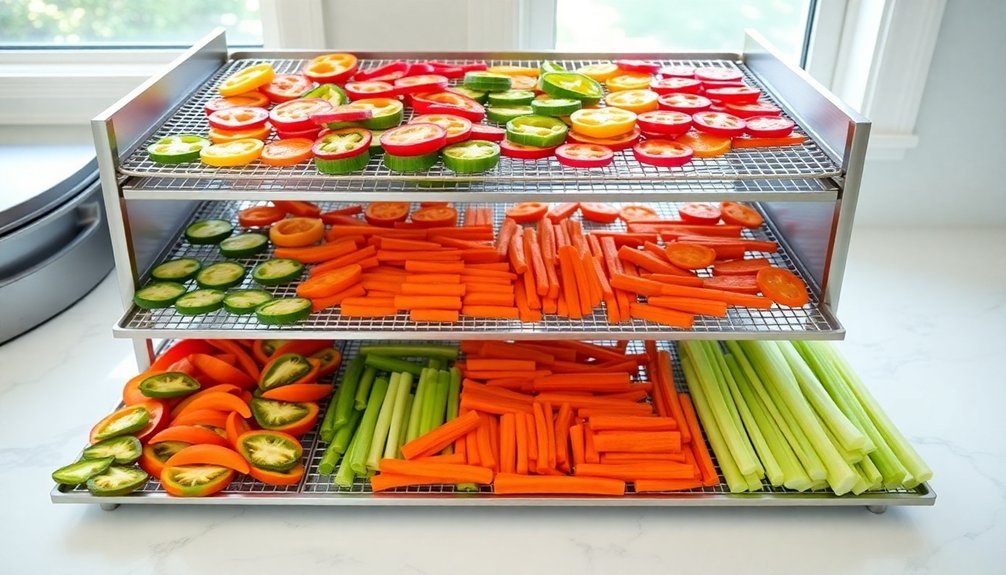
The success of shelf-stable vegetable powder begins with proper preparation. You'll need to carefully select vegetables that are suitable for dehydration, removing any damaged or bruised portions. While peak freshness isn't essential, you'll want to guarantee your vegetables are still of good quality, as dehydration won't improve their condition.
Before dehydrating, you must properly clean and prepare your vegetables. Here's what you need to do:
- Wash vegetables thoroughly, removing any grit or dirt, especially from textured vegetables like broccoli.
- Cut vegetables uniformly to guarantee even drying, such as snapping green beans in half or slicing carrots consistently.
- Blanch most vegetables in boiling water, followed by an immediate ice bath – this maintains color and improves rehydration.
- Steam certain vegetables like broccoli and okra for 5-6 minutes to enhance digestibility.
If you're short on time, you can use frozen vegetables instead. Simply rinse them under warm water to break up chunks, drain well, and spread evenly on your dehydrator tray.
Whether using fresh or frozen, maintain a dehydration temperature of 125°F until the vegetables are completely dry and hard.
Solar Drying Equipment Setup
Your solar dryer needs a heat-absorbing black base, clear plastic covering, and well-positioned mesh trays that allow proper airflow through the drying chamber.
You'll want to place your dryer at a 90-degree angle to the sun's path on level ground, ensuring the first tray remains empty to allow air heating before reaching your produce.
To maintain ideal drying temperatures around 130°F, you'll need to monitor and adjust the vents while rotating the trays 2-3 times throughout the drying process.
Solar Drying Design Basics
Setting up a solar dryer requires several key components working together to enhance heat collection and airflow.
You'll need a frame made from wood, metal, or bamboo poles to create the basic structure. Cover this frame with transparent plastic or greenhouse-grade material to trap solar heat while allowing sunlight to penetrate.
Inside your dryer, you'll want to include:
- A black-covered drying surface that absorbs maximum heat and transfers it to your produce
- Multiple mesh trays or shelves that allow air to circulate freely around your vegetables
- A properly sized ventilation system with both lower and upper openings to create continuous airflow
- A chimney or exhaust vent to remove moisture-laden air efficiently
For best performance, you'll want the internal temperature to run about 10-15°C above the outside air temperature.
Position your dryer to capture maximum sunlight, and make sure there's enough space between produce pieces on your drying trays. The design should be flexible enough to accommodate different vegetable sizes and quantities.
Equipment Placement And Position
Proper placement and positioning of solar drying equipment greatly impacts your drying results. You'll need to position your dryer in direct sunlight, guaranteeing it's oriented to maximize sun exposure throughout the day. Place it on level ground and away from any structures that might cast shadows.
| Key Factor | What to Do | Why It Matters |
|---|---|---|
| Air Flow | Leave gaps between covers and trays | Prevents product burning and guarantees even drying |
| Heat Collection | Use black surfaces below trays | Warms incoming air and reduces humidity |
| Chimney Setup | Position at dryer's end | Creates natural air circulation |
Your setup should create a natural flow where cool air enters through the bottom vent, warms up across the heat-absorbing surface, and exits through the chimney. Don't load your first tray position – let it serve as a heating zone. When loading products, place thinner items closer to the chimney and thicker pieces toward the air intake. You'll want to rotate your trays 2-3 times during drying for uniform results. Before first use, let your dryer sit in the sun for several days to release any fumes from paint or silicon.
Temperature Control Methods
Temperature control in solar drying demands a multi-faceted approach combining sensor technology and airflow management.
You'll need to implement NTC sensors to monitor chamber temperatures and use microcontrollers to regulate fan operation when temperatures exceed your set points by 5% or more. The system should automatically adjust airflow through transistor-controlled fans, guaranteeing your produce maintains ideal drying conditions.
To achieve precise temperature control in your solar dryer, follow these essential steps:
- Install clear polyethylene film tightly across your drying table, making sure it doesn't touch the produce while maintaining proper airflow.
- Leave the first tray position empty as a preheat zone, allowing air to warm before reaching your vegetables.
- Cover the drying table with black material to enhance heat absorption and maintain consistent temperatures.
- Rotate trays periodically to guarantee uniform drying, especially for thicker items with higher moisture content.
For reliable temperature regulation, you'll want to incorporate a proportional corrector in your control system.
Monitor humidity levels rather than time to determine when your vegetables are properly dried, as this proves more reliable when dealing with variable solar energy conditions.
The Dehydration Process
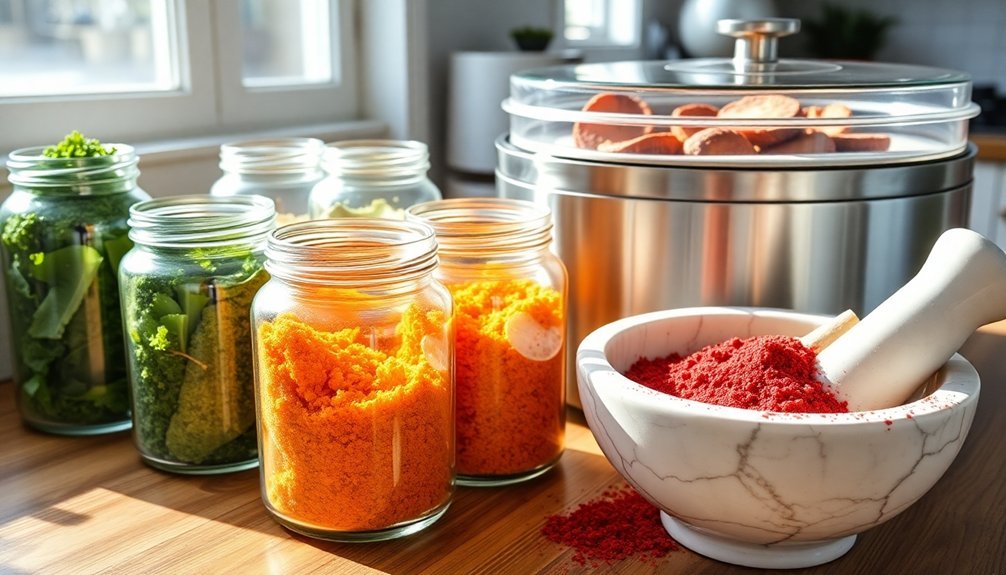
You'll need to dry your vegetables for 8-12 hours, checking them periodically to guarantee they're drying evenly.
Rotate or adjust the trays if necessary. Your vegetables are ready when they're completely dry and hard to the touch.
Let them cool entirely before transferring them to airtight containers for storage.
When stored properly in a cool, dark place, they'll maintain their quality for up to one year.
Grinding Your Dried Vegetables
Before you start grinding your dehydrated vegetables, verify you have the right equipment, such as a high-speed blender, food processor, or spice grinder, and inspect it for cleanliness and proper operation.
You'll need to process your vegetables in short bursts to prevent overheating both the equipment and the produce, which can compromise the quality of your powder.
To maintain consistent quality, sift the ground powder between processing cycles and check that the final product is uniformly fine before storing.
Equipment and Safety Tips
Selecting the right equipment and following proper safety protocols are essential steps in creating high-quality vegetable powder. You'll need a stainless steel grinder with adjustable sieves and sufficient power (around 1.1 kW) to process your dried vegetables efficiently. The grinder should be specifically designed for dry materials and include features like a loading pestle and collection bags for easy operation.
When operating your grinding equipment, always prioritize safety and maintenance. Before each use, check the rotation direction and verify the grinding chamber is free from foreign objects. Don't forget to wear protective gear when operating the machine, and keep water away from electrical components during cleaning and operation.
Key safety measures for peak grinding results:
- Inspect your equipment regularly for signs of wear, focusing on the grinding chamber and knives.
- Train yourself on proper loading techniques, using the pestle to feed material slowly.
- Clean the grinder thoroughly after each use, avoiding water contact with electrical parts.
- Maintain proper maintenance schedules and replace worn parts promptly.
Always follow the manufacturer's instructions for peak performance and safety while creating your vegetable powder.
Quality Control Measures
After achieving proper dehydration, maintaining strict quality control during the grinding process guarantees a consistent, high-quality vegetable powder.
You'll need to inspect your dried vegetables thoroughly before grinding, confirming they're brittle and completely moisture-free. Test this by placing them in a sealed container for 24 hours to check for any condensation.
When you're ready to grind, use a high-powered blender or food processor to create your powder. You'll want to sift the ground product through a fine mesh to confirm uniform consistency. If you find larger pieces, simply return them to the grinder for another pass.
Monitor the powder's texture and appearance throughout the process, checking for any signs of clumping or discoloration.
Store your finished powder in airtight containers away from light and humidity. You'll need to perform regular quality checks to confirm your powder maintains its proper consistency and remains free from contamination.
If you notice any irregularities, such as moisture absorption or color changes, don't use the powder. Remember to date your containers and rotate your stock to maintain freshness and quality standards.
Proper Storage Methods
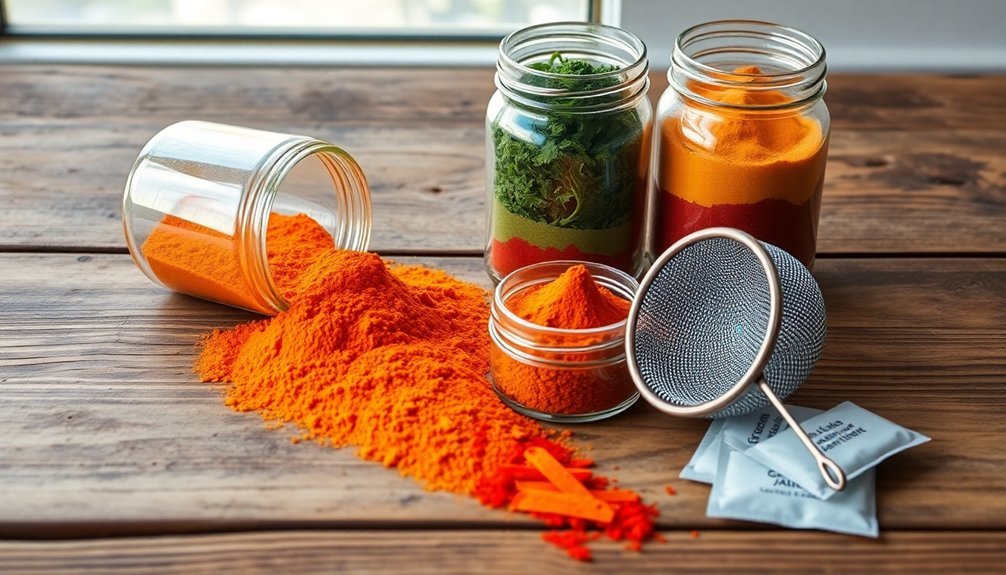
Preserving the quality of your veggie powder starts with proper storage methods. You'll want to store your powder in airtight containers, such as glass jars with tight-fitting lids or vacuum-sealed bags. Avoid using regular zip-top bags, as they won't provide adequate protection against air and moisture. For best results, add silica gel packets to your storage containers to prevent clumping.
Choose your storage location carefully based on how long you plan to keep your veggie powder. While a cool, dry pantry works well for several months, you can extend shelf life by refrigerating or freezing the powder. Just remember to use moisture-resistant containers to prevent condensation when moving between temperatures.
- Transfer small amounts to daily-use containers to minimize repeated opening of your main storage.
- Label all containers with packaging dates to track freshness.
- Leave minimal headspace in containers to reduce air exposure.
- Keep containers away from direct sunlight and strong-smelling foods.
When handling your veggie powder, always use clean, dry utensils to prevent contamination. If you notice any clumping, gently break up the powder with a fork or sift it before use.
Check regularly for signs of spoilage, including unusual odors or discoloration.
Maximizing Shelf Life
The right storage practices lay the foundation for longevity, but there's more you can do to maximize your veggie powder's shelf life. Using clean, dry utensils every time you scoop prevents moisture and contaminants from compromising your powder. You'll want to divide larger quantities into smaller portions to minimize repeated air exposure.
| Storage Factor | What to Do | What to Avoid |
|---|---|---|
| Temperature | Keep in cool, stable spots | Avoid heat and fluctuations |
| Light | Use opaque containers | Skip clear containers |
| Air | Minimize headspace | Don't leave partially empty |
| Moisture | Add desiccant packets | Never use wet utensils |
| Packaging | Choose airtight seals | Avoid flimsy containers |
You'll know your powder's still good when it maintains its original color, texture, and smell. For peak freshness, refrigerate after opening and use within 3-6 months. If you're storing at room temperature, keep it in a dark pantry and aim to use it within 3 months. Consider vacuum-sealing portions you won't use immediately, as this can extend shelf life up to 12 months.
Best Uses For Vegetable Powder
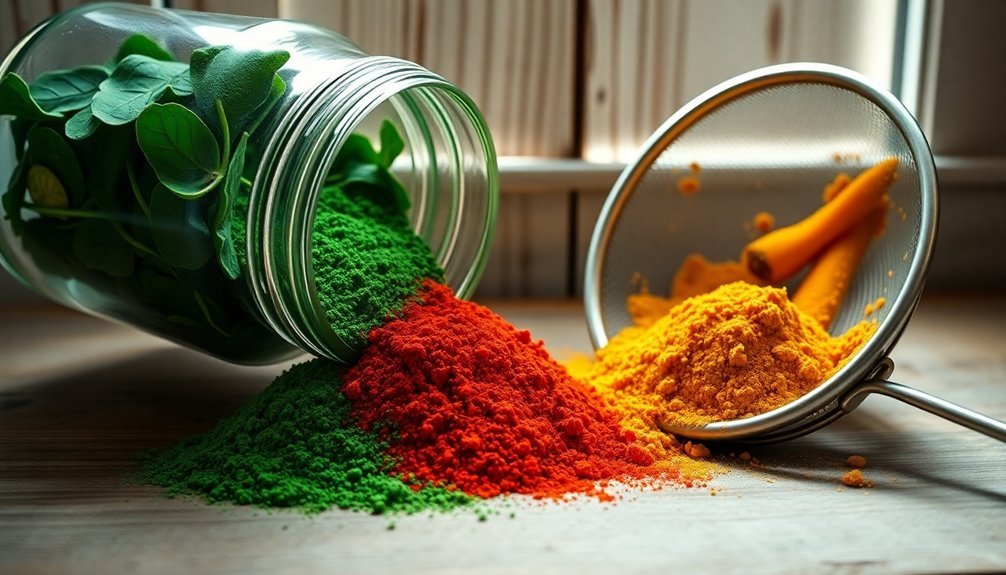
Versatile vegetable powders can transform everyday cooking into nutrient-rich culinary experiences. You'll find endless ways to incorporate these concentrated ingredients into your daily meals, from enhancing flavors to boosting nutritional content.
Create custom seasoning blends by mixing vegetable powders with your favorite herbs and spices. You can use these blends to make flavorful marinades, dry rubs, or unique salts that'll elevate any dish.
For baking enthusiasts, try incorporating vegetable powders into bread doughs, pastries, and pasta to add both nutrition and natural color.
Here's how to make the most of your vegetable powders:
- Blend into smoothies with fruits and yogurt for an instant nutrition boost
- Mix into soups, stews, and sauces to enhance depth of flavor
- Add to scrambled eggs or omelets for extra nutrients and taste
- Incorporate into homemade pasta dough for vibrant, healthy noodles
You can also use vegetable powders to create low-sodium broths, boost protein content in casseroles with bean powders, or add natural color to baked goods.
Their versatility makes them an essential ingredient for both everyday cooking and creative culinary experiments.
Nutrition And Health Benefits
Super-concentrated nutrients pack a powerful punch in shelf-stable vegetable powders, offering an impressive array of health benefits and essential vitamins. When you consume vegetable powders, you'll get concentrated doses of minerals like iron, calcium, and potassium, which help maintain healthy blood pressure and support overall wellness.
You'll benefit from the powder's preserved antioxidants, including vitamins C and K, which combat chronic diseases and support immune function. The concentrated dietary fiber can reduce your risk of colorectal cancer, while vitamin K contributes to better eye health and may help prevent age-related dementia.
Your body can effectively absorb these nutrients, as studies show increased blood levels of carotenoids, lutein, lycopene, and various vitamins after supplementing with vegetable powders. While some water-soluble vitamins may decrease during the dehydration process, you'll still get a significant portion of the original nutrients in a more concentrated form.
Although fresh vegetables offer the complete package of nutrients and a superior sensory experience, vegetable powders provide a convenient, long-lasting alternative that can help you boost your daily vegetable intake with minimal preparation time.
Frequently Asked Questions
Can Vegetable Powders Be Mixed Together to Create Custom Nutrient Blends?
Yes, you can mix different vegetable powders to create your own nutrient-rich blends. You'll get customized nutritional profiles when combining powders from roots, greens, and other veggies based on your specific needs.
How Do Different Dehydration Temperatures Affect the Final Powder Color?
You'll notice higher dehydration temperatures make your powder darker and more intensely colored. At 80°C, you'll get the richest reds, while too-high temps over 90°C can damage pigments and dull colors.
What Happens if Moisture Accidentally Gets Into the Powder Container?
If moisture gets into your powder container, you'll notice clumping, potential mold growth, and chemical degradation. It'll reduce shelf life and could reactivate harmful microorganisms. Don't use contaminated powder – discard it immediately.
Are There Specific Vegetables That Should Not Be Turned Into Powder?
You can technically powder any vegetable, but you'll want to avoid very watery ones like cucumber or watermelon, as they're harder to dehydrate properly and don't yield much powder for the effort.
Can Homemade Vegetable Powder Be Used as Natural Food Coloring?
Yes, you can use homemade vegetable powder as natural food coloring. You'll get vibrant results from beets (red), carrots (orange), and spinach (green). It's a safe, natural alternative to artificial dyes.
In Summary
You'll find vegetable powder to be a game-changing addition to your pantry. By following proper dehydration and storage techniques, you're able to preserve fresh produce for months while maintaining essential nutrients. Whether you're sprinkling it into soups, smoothies, or seasonings, these concentrated powders pack powerful nutrition into small servings. Start with simple vegetables like carrots or greens, and you'll soon master this practical preservation method.
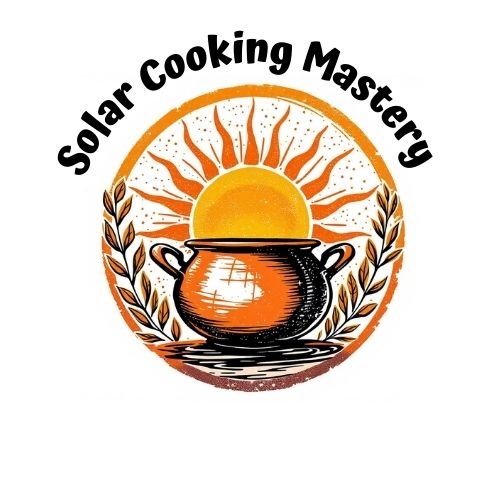
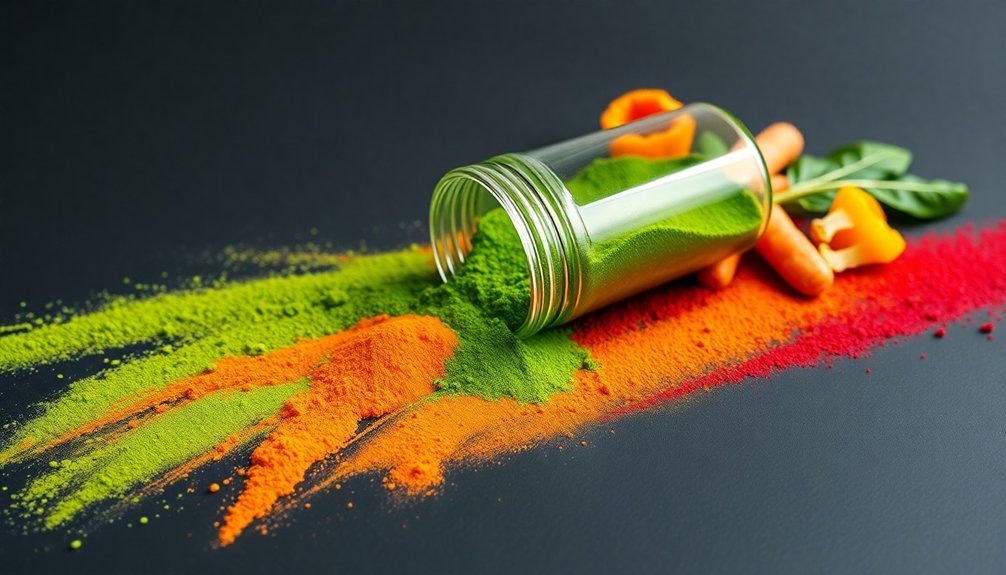

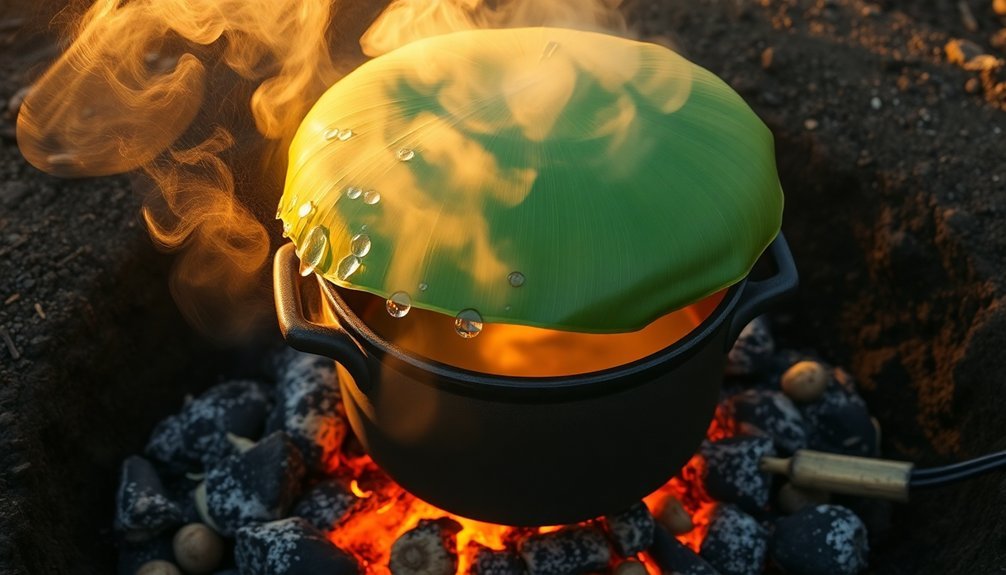

Leave a Reply